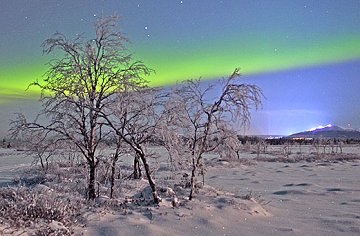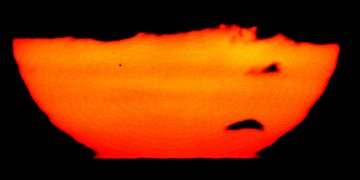 Autumn is here, and it's a wonderful time for stargazing. Find out what's up from Spaceweather PHONE.
Autumn is here, and it's a wonderful time for stargazing. Find out what's up from Spaceweather PHONE.
FOUR PLANETS: Jupiter, Venus, Mars and Mercury are all crowded around the sun this weekend. The great conjunction is invisible to the human eye (too much sunlight), but SOHO can see it. The spacecraft's coronagraph is able to block the glare and reveal the planets. Take a look: live image, finder chart.
AURORA WATCH: A solar wind stream is buffeting Earth's magnetic field and causing auroras at high latitudes. Last night in Finland, Sauli Koski snapped this picture:

When the solar wind stream first hit Earth on Nov. 9th, the impact spread auroras as far south as Illinois in the United States. Since then, the display has retreated to Alaska, Canada and Scandinavia. Oh, to be in Finland!
November 2006 Aurora Gallery
TRANSIT OF MERCURY: When the Transit of Mercury began last Wednesday, Nov. 8th, the sun had already begun to set over the tiny Caribbean island of St. Maarten. This gave island photographer Stephen Thompson a chance to take a truly unusual picture:

"The sun was less than 0.5o above the water," says Thompson. Low-hanging clouds blocked the top of the sun while a layer of warm air near the sea surface stretched the sun into a strangely-shaped mirage. Mercury, meanwhile, was little affected. It is the tiny circular dot just left of center.
"The lower 'flange' is an inverted image of the sun," notes atmospheric optics expert Les Cowley. "If only Mercury had transited the sun closer to the ocean we might have seen it imaged twice."
Transit of Mercury Photo Gallery
Updated daily

